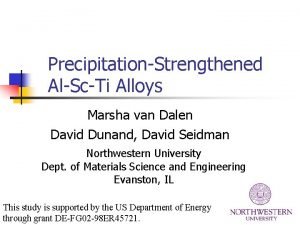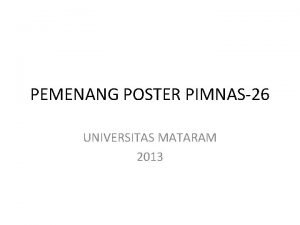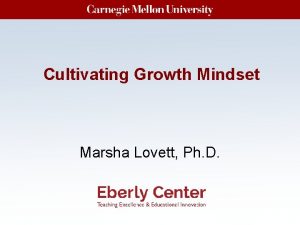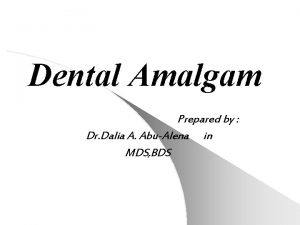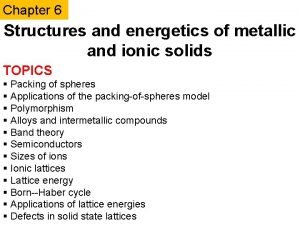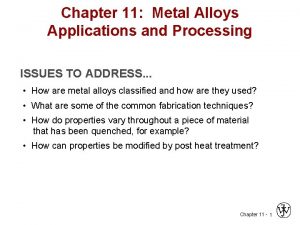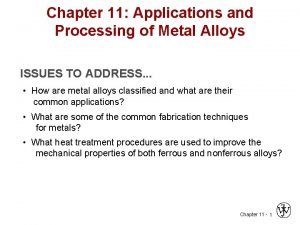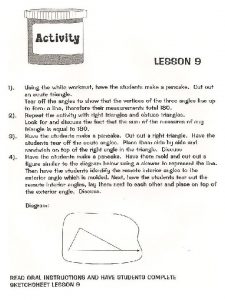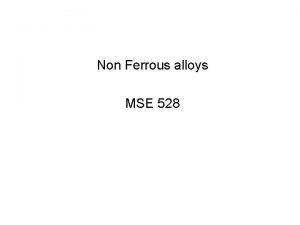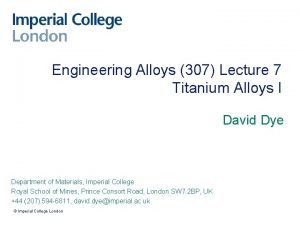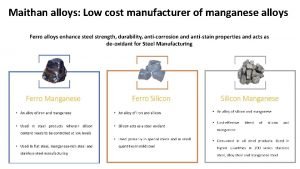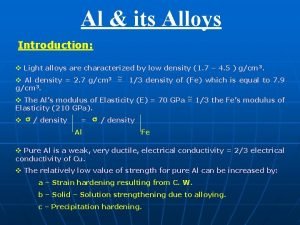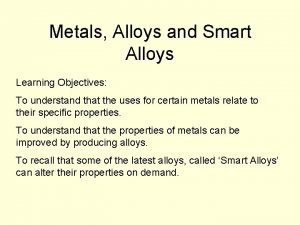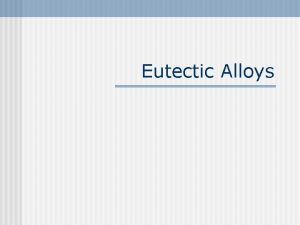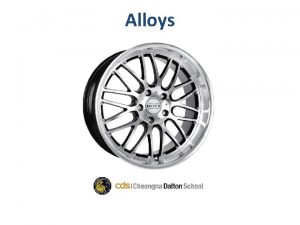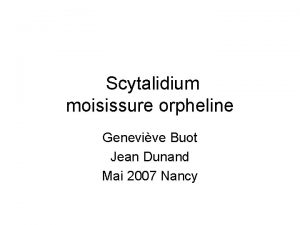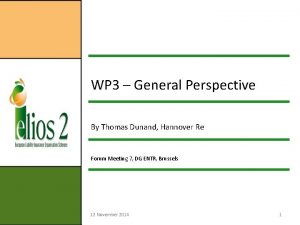PrecipitationStrengthened AlScTi Alloys Marsha van Dalen David Dunand























- Slides: 23

Precipitation-Strengthened Al-Sc-Ti Alloys Marsha van Dalen David Dunand, David Seidman Northwestern University Dept. of Materials Science and Engineering Evanston, IL This study is supported by the US Department of Energy through grant DE-FG 02 -98 ER 45721.

Introduction: Al-Sc alloys n n n 1 Polmear 2 Marquis Most current Al alloys are limited to low temperature usage (<200ºC ) because of the dissolution and/or coarsening of their precipitates. 1 Al-Sc alloys, however, form nanosize, coherent Al 3 Sc (L 12 structure) precipitates which exhibit low coarsening rates at 300ºC-350ºC. Significant improvement in creep resistance over pure Al. 2 IJ, Light Alloys: Metallurgy of the Light Metals, Edward Arnold 1981. EA, Seidman DN, Dunand DC, Acta Mat. 50 (2002) 4021 -4035. L 12 Structure Al atoms Sc atoms

Al-Sc Phase Diagram n n n 1 Hyland, Sc has limited solid solubility in -Al. Sc is most potent strengthener on a per atom basis. More potent than Zn, Cu, Mg, Li and Si. 2 Met. Trans. A, 23 A (1992) 1947 -1955. 2 Drits M Ye. , Ber LB, Bykov YG, Toropova LS, Anastas'eva GK, Phys. Metall. , 57 (6) (1984) 118 -126. -Al + Al 3 Sc

Ternary alloying elements Ternary additions can alter the properties of Al-Sc alloys. n n Mg for solid solution strengthening Zr partitions to Al 3 Sc phase n n n 1 Fujikawa Diffusivity of Zr is over 4 orders of magnitude smaller than Sc 1 at 300ºC which leads to a lower coarsening rate compared to the binary. Reduces the lattice parameter mismatch 2 between Al and Al 3 Sc which also leads to a lower coarsening rate. Segregates to the -Al/Al 3 Sc heterophase interface. 3 SI, Defect and Diff. For. 143 -147 (1997) 115 -120. 2 Harada & Dunand, Mater. Sci. & Eng. A, 329 -331 (2002) 686 -695. 3 C. B. Fuller, J. L. Murray, D. N. Seidman, to be submitted for publication, 2005.

Al-Sc-Ti alloys Ti as a ternary alloying element: n Low diffusion rate in Al n n High solubility in Al 3 Sc 2 n n n 1 Bergner Smaller than Zr by factor of ca. 20 at 300ºC 1 Replacing up to 50% of Sc atoms. Ti reduces the lattice parameter mismatch between -Al and Al 3(Sc, Ti) precipitates. Has the potential of reducing the coarsening rate since the diffusion and elastic strain energy are reduced. D, Van Chi N, Wissens. Zeit. der Padag. Hochschule “N. K. Krupskaja” Halle XV (1977), Heft 3. 2 Harada & Dunand, Mater. Sci. & Eng. A, 329 -331 (2002) 686 -695.

Al-Sc-Ti Ternary Phase Diagram n Composition analyzed: n n Al-0. 06 at. %Sc-0. 06 at. %Ti The composition is in the single phase -Al region during homogenization at 640ºC. It is in the three phase region during aging at 300ºC and 350ºC. No Al 3 Ti precipitates were observed. 350ºC 300ºC J. L. Murray, ALCOA

Vickers Microhardness 1 hr 1 day 1 week n n Sc is more effective strengthener at room temperature than Ti. Even the addition of 0. 005 at. % Zr increases the hardness to several hundred MPa over the alloy with Ti additions. E. A. Marquis, D. N. Seidman, D. C. Dunand, Acta Mater. 51 (2003) 4751 -4760. E. A. Marquis, D. N. Seidman, Acta Mater. 49 (2001) 1909 -1919. C. B. Fuller, Ph. D Thesis, Northwestern University, 2003

Vickers Microhardness 1 hr n Significant hardening at 300ºC n n n Overaging occurs after 16 days. Decrease in hardness with increasing temperature due to coarsening of ppts. No significant hardening above 320ºC n n 1 day 1 week Due to heterogeneous nucleation at higher temperatures Still significant hardening for samples aged at 300ºC first before aging at higher temperatures likely due to diffusion of Ti into the precipitates. Triple Aged Sample: 300ºC/24 h - 400ºC/10 days - 450ºC/48 h Double Aged Sample: 300ºC/24 h - 425ºC/48 h

Precipitate Morphology Dark Field TEM images showing changes in precipitate size, shape and distribution with aging treatment: (a) 300 C / 64 days [110] zone axis; (b) 320 C / 1 day. [100] zone axis; (c) 330 C / 1 day. [211] zone axis; (d) 300 C / 1 day, 400 C / 10 days, 450 C / 2 days, [110] zone axis.

Coherency of Al 3 Sc Precipitates n n n 1 E. A. The Al 3 Sc precipitates remain coherent up to temperatures of 320ºC The precipitates display Ashby-Brown strain contrast typical of coherent precipitates. Consistent with binary alloys in which precipitates remained coherent up to 40 nm in diameter. 1 Marquis, D. N. Seidman, Acta Mater. 49 (2001) 1909 -1919. BF TEM image of Al-0. 06 Sc-0. 06 Ti aged at 320ºC for 24 h.

Coarsening Models n n n LSW Coarsening Theory predicts for binary alloys for steady-state: 1, 2 1/3 n Average precipitate radius, <R> t -1 n Precipitate Number Density t -1/3 n Supersaturation t For ternary alloys the time exponents are the same. 3 Assumptions: n n n 1 Lifshitz Negligible volume fraction. No elastic interaction among ppts. Ppts. have spherical shape and are randomly distributed. Only takes into account diffusion - not coagulation or coalescence of precipitates. Composition of precipitates and matrix is in quasi-steady-state, i. e. d. C/dt 0 Off-diagonal terms of diffusion tensor neglected. IM, Slyozov VV, J Phys. Chem. Solids, 19 (1961) 35 -50. 2 Wagner C, Z. Elektrochem, 65, (1961) 581 -591. 3 Kuehmann CJ, Voorhees PW, Met. Mat. Trans. A, 27 A (1996) 937 -943.

Precipitate Size vs. Time at 300ºC n n 1 C. B. Average precipitate radius only increases slightly with time for aging at 300ºC. Much smaller time exponent than predicted. Similar trends observed for Al-Sc-Zr alloys. 1 Indicates coarsening is occurring more slowly than predicted by coarsening models. Fuller, Ph. D Thesis, Northwestern University, 2003

3 -Dimensional Atom Probe (3 DAP)

3 DAP Microscopy Results 3 D reconstruction showing Al 3 Sc precipitate in sample aged for 96 h. at 300ºC ~125, 000 atoms • Sc atoms • Ti atoms Al atoms omitted for clarity.

3 DAP Microscopy Results: Ti Concentration vs. Time n n n Ti concentration in Al 3 Sc precipitates increases with time at 300ºC. Only small amount incorporated into the ppts. since the diffusion of Ti in Al is slow. Apparent interfacial segregation at longer aging times. Similar to results obtained for Al-Sc-Zr alloys. Based on 9 at. % Sc isosurface. Proximity Histogram of Ti for various aging times matrix precipitate

3 DAP Microscopy Results: Concentration vs. Time n n n Sc concentration in precipitate phase decreases over time. Sc atoms replaced by Ti atoms. System thus not in equilibrium.

Ti concentration in matrix n n Decreases slowly with aging time. Far from equilibrium value of 0. 01 at. % n n At 0. 04 at. % after 64 days. Concentration changing significantly thus not in equilibrium.

High Temperature Coarsening n Increased Ti in precipitate after double aging n n 24 hrs. at 300ºC 120 hrs. at 400ºC Diffusion distance for 64 days at 300ºC: 3 nm Diffusion distance for double aging treatment: 48 nm Data for Double Aging Taken with Imago Scienentific LEAP microscope.

Trends in Segregation of Ti to Interface n Segregation increases with aging time at 300ºC n n n Less segregation than Zr n n Due to slower diffusion in ppt. Interfacial energy is reduced. Possibly because Ti is more effective at reducing the lattice parameter. Less segregated after aging at 400ºC n Lower mismatch at higher temperatures.

Room Temperature Strengthening Mechanisms n n Orowan looping seems to be the dominant mechanism. All other mechanisms lead to stresses that would be much too high at the radii measured. n n order strengthening modulus mismatch coherency strains Fairly good agreement with previous studies. 1, 2 1 Marquis EA, Seidman DN, Dunand DC, Acta Mat. 50 (2002) 4021 -4035. 2 Fuller, CB, DN Seidman, DC Dunand, Acta Materialia 51 (2003) 4803 -4814. Calculated Orowan Stress

Creep of Al-0. 06 Sc-0. 06 Ti at 300ºC n n n High apparent stress exponents indicative of threshold stress. For radii in the range 5. 8 -10. 8 nm, creep resistance and threshold stress increases with increasing precipitate size. At largest average precipitate radius (16. 9 nm), however, the interprecipitate distance is so large that the creep resistance has decreased.

Normalized Threshold Stress n n Most climb related models predict normalized threshold stress to be constant with radius. Increase of norm with increasing radius due to lattice and elastic misfits. 1 n n Consistent with Al-Sc, Al. Sc-Mg 2 and Al-Sc-Zr 3 Slight decrease in creep properties for the Al-Sc-Ti alloy due to lower lattice misfit. norm = th/ or 1 Marquis EA, Dunand DC, Scripta Mat. 47 (2002) 503 -508 EA, Seidman DN, Dunand DC, Acta Mater. 51 (2003) 4751 -4760. 3 Fuller CB, Seidman DN, Dunand DC, Acta Mater. 51 (2003) 4803 -4814. 2 Marquis

Conclusions n n Ti does not provide as much of a strengthening effect at room temperature as an equal addition of Sc or Zr to pure aluminum. Ti partitions to the precipitates, although this is a very slow kinetic process and at the aging times analyzed, most of the Ti remains in solid solution in the matrix. The coarsening of the precipitates does not agree exactly with coarsening model - slower than predicted. A creep threshold stress is found at 300ºC, which when normalized by the Orowan stress, increases with increasing precipitate radius. Qualitative agreement is found with a model considering climb with elastic interactions with the precipitate.
 Marsha marsha marsha marsha marsha marsha
Marsha marsha marsha marsha marsha marsha David dunand
David dunand Irene van dalen
Irene van dalen Marsha vernoga
Marsha vernoga Sex anime
Sex anime Marsha colbey
Marsha colbey Hippotherapy pronunciation
Hippotherapy pronunciation Marsha slough
Marsha slough Marsha chan
Marsha chan Marsha faradina
Marsha faradina Marsha chechik
Marsha chechik How learning works
How learning works Marsha garrett middlesbrough
Marsha garrett middlesbrough Marsha garrett middlesbrough
Marsha garrett middlesbrough Introductions by marsha
Introductions by marsha Both greta and fred were on the bus that arrived
Both greta and fred were on the bus that arrived Polk county property appraiser map
Polk county property appraiser map Marsha pierce
Marsha pierce Marsha warren
Marsha warren Microfusion cast & alloys
Microfusion cast & alloys Phases of amalgam
Phases of amalgam Substitutional alloy examples
Substitutional alloy examples Calister
Calister Applications and processing of metal alloys
Applications and processing of metal alloys

